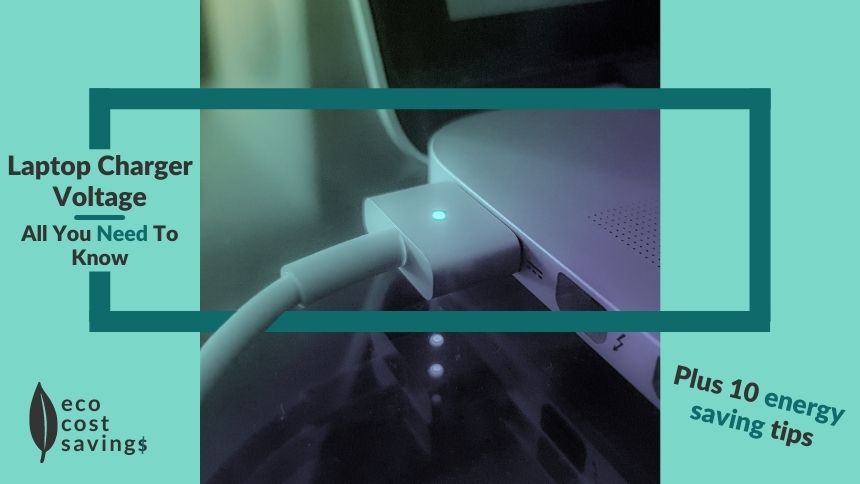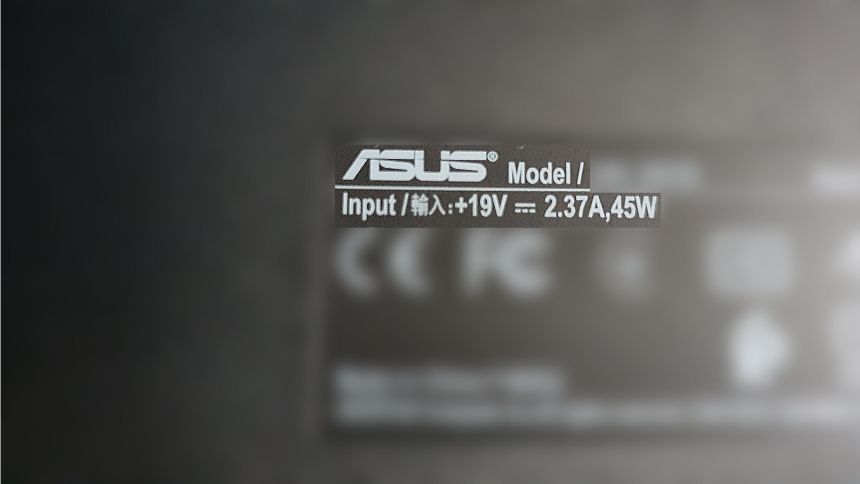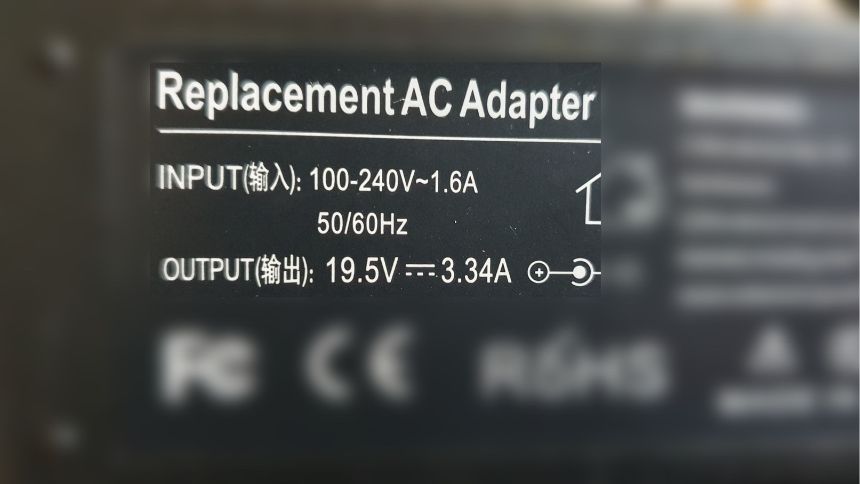Last updated: February 14, 2024.
Laptop charger voltage requirements differ. Input voltage is different from place to place and output voltage requirements vary by laptop model. Get key laptop voltage considerations, safety, and energy saving tips below.
Did you know universal chargers are not exactly universal? And that charging a laptop with the wrong power adapter can be dangerous?
In this post you’ll get key laptop charger voltage details, see how you can find your voltage requirements to help you ensure safety when choosing a laptop charger, and access 10 easy to implement energy saving tips for laptops.
If you’re in the market for a new laptop charger, one of Amazon’s best selling and highest rated “universal” laptop chargers is suitable for a very wide variety of laptops – check it out, here.

Laptop voltage
Laptops typically require a 19V DC input and offer a 5V DC output via USB ports.
Laptop chargers and adaptors convert, and then deliver, specific input power options for laptops.
Laptop chargers and adaptors are often referred to as “laptop power adaptors”, “laptop AC adaptors”, “laptop adaptors” or simply “laptop chargers”. I’ll refer to them as laptop chargers in this post.
Laptop chargers convert AC electricity from standard outlets (i.e. the charger’s input power) into a DC power supply (i.e. the charger’s output power) for the laptop.
Laptop charger output power should match the laptop’s input power requirements, including its voltage requirement.
The input voltage for laptop chargers is typically 100-240V AC, while the output voltage is typically 19V DC. This, as mentioned, is a common input voltage requirement for laptops.
Not all chargers, however, deliver a suitable voltage for all laptops…
Continue reading for more details including how you can find your laptop’s voltage and overall power supply requirements, and how you can reduce the impact your laptop is having on your electric bill and carbon footprint.
Laptop charger voltage
Laptop charger voltage is usually 100-240V AC (input) delivering a 19V DC output.
This means that most laptop chargers convert mains electricity, that have voltages between 100V (110V is common in the US) and 240V (common in the UK), into 19V to power the laptop and charge its battery.
The vast majority of power grids around the world deliver voltage that ranges between 100-240V.
As a result, the input voltage requirements for most laptop chargers is suitable for most countries.
There are laptop chargers that offer a wider input voltage ranging from 95-250V, but these are a lot less common.
It’s always good to verify your input voltage and output voltage requirements before getting a new charger.
How to identify your laptop charger voltage requirements
The information should be listed on your old laptop charger. Here’s a picture of my ASUS VivoBook’s laptop charger voltage and general input and output power requirements:

As you can see, the ASUS VivoBook’s laptop charger (that was shipped with the device) has an input voltage requirement of 100V to 240V AC. The input amperage and frequency requirement is 1.0A and 50/60Hz respectively.
Related post: How Many Amps Does A Laptop Use? [+ Laptop Battery Capacity Insights].
This charger lists the output power. This is useful because if you need to replace the charger you can simply reference the output power requirements on the charger.
If your charger doesn’t have its voltage listed, it’s still very easy to identify your laptop charger voltage requirements.
To do this, simply identify your mains voltage (a quick search online should be sufficient) and your laptop’s voltage requirements (it should be noted on a sticker on the underside of your laptop or you can simply look online / check the manual).
I know the mains voltage in my area in the US is 110V (it should be noted on my energy supplier’s website too). And, from looking at the underside of my laptop, I can see that I need an input voltage of +19V:

As you can see, the ASUS Vivobook requires a charger that delivers at least 19V DC at 2.37 amps, with the overall wattage / power requirement being 45W (this is the power rating of the device).
Sidenote: the voltage multiplied by the amps will give the power. For example, in this case, 19V x 2.37A = 45W.
The input voltage (and overall power specs) of the laptop should be the same as the output voltage (and overall power specs) of the charger.
This is the case in the 2 images above. The output power of the charger matches the laptop’s input power requirements.
People looking for laptop charger voltage requirements tend to be in the market for a new laptop charger. And universal laptop chargers tend to be a popular option.
However, there are some things that you should know about “universal” laptop chargers and laptop chargers in general.
Are laptop chargers universal?
Laptop chargers are not universal.
The chargers that are shipped with laptops vary and usually don’t work with other laptop brands.
Laptop input power requirements are nearly universal due to the range that most laptop chargers cater to. However, the output power requirements from the charger tend to be different.
This is because different laptop models have different voltage and amperage requirements.
The power supply ports tend to be different too. For example, HP laptops have a different port than Dell laptops. As a result, you cannot plug a HP laptop charger into a Dell laptop – it just won’t fit.
However, “universal” laptop chargers do exist.
These are not 100% universal, but they cater to enough laptop models that manufacturers feel they can make the claim.
If you require a new laptop charger and are choosing a universal charger, it’s important to know that it caters to your laptop. This is not just for efficacy reasons but also for safety. Using an incorrect charger can create risk of electric shock and fire.
As a result, it’s important to check charger product descriptions and know your input power requirements and what output power you need for your laptop.
One of Amazon’s best selling and highest rated universal laptop chargers is suitable for a very wide variety of laptops – check it out, here, or, here.
It’s compatible with a substantial number of laptops – all listed on the product page. And as you’ll see there, it has various output voltages, high energy conversion efficiency, and built-in overload / over-voltage protection.
Many universal laptop chargers can deliver different output voltages. This one that I have has a selector for different output voltage options:

The switch on the top adjusts the voltage output, expanding the number of laptop models that this charger works with.

However, chargers don’t tend to provide a voltage selector.
Here’s an example of the input and output power of another “universal” charger that I have.

The limited output power reduces the number of devices that this “universal” charger works with.
Universal laptop chargers tend to list the devices that they cater to, but as mentioned, it’s always good to verify.
Verify that it caters to your input and output voltage requirements as covered above, along with your Hz, amperage and port requirements.
You’ll most likely have a 50/60Hz supply and universal chargers tend to always cater to that. But again, it’s best to verify. Check the input supply in your area (could search online) and see if it is catered to by the universal charger.
Laptops require DC power, so there’s no need to check what Hz your laptop requires. The charger will convert AC to DC, removing the frequency (Hz).
It’s more important, from a safety perspective, to check that the charger amperage matches up with your laptop’s amp requirements. You should be able to see your laptop’s amp requirements on the underside of your laptop or you may need to search online.
Ensuring that these match up is important.
It’s always good to verify that the wattage lines up too. If you checked the voltage and amps already, this is not essential but it’s worthwile just in case the product details don’t add up.
Your laptop’s wattage requirements should be listed on the underside of your laptop, but you may need to look online. The most common laptop wattage is 65W.
Finally, check that the universal charger has a suitable power port connector. Compatibility should be clearly stated in the product description.
If you are looking to buy a new laptop charger, don’t forget to recycle your old one. Best Buy usually has an e-waste recycling facility just inside their door. Many other retailers offer the same service.
Reduce your laptop running costs and carbon footprint
I researched over a thousand laptops to find out how many watts a laptop actually uses and to give energy efficiency insights.
Check out the 10 easy to implement tips to reduce your laptop electricity costs, here.
Want to make bigger cost and carbon footprint savings?
Stop wasting 28% of your electricity, start saving $32.28 per month – get the 6 Quick Wins Cheat Sheet:
-
How Many Watts Does A Laptop Use? [Actual Usage & Costs Revealed – 1,084 Studied]
Based on laptop power consumption tests, get the actual answer to: how many watts does a laptop use? Plus, get key laptop wattage details, running costs & get 10 effective cost saving tips, here.
-
Laptop Charger Voltage – All You Need To Know [W/ Eco Tips]
Laptop charger voltage requirements differ. Input voltage is different from place to place and output voltage requirements vary by laptop model. Get key laptop voltage considerations, safety and energy saving tips here.
-
How Many Amps Does A Laptop Use? [+ Laptop Battery Capacity]
See how many amps a laptop uses, and get insights into laptop battery capacity and battery life, here. Results are based on over 114 different laptops.
James, Eco Cost Savings co-founder and Editor-in-Chief, is also our experienced in-house energy management and sustainability expert, and manager of our network of sustainability consultants.
Before his journey into sustainability, James studied engineering. Additionally, he has experience in HVAC installation, and data analysis. A self-proclaimed practical environmentalist, and avid penny pincher, James established Eco Cost Savings to share his and his colleague’s expertise with the aim of helping to reduce energy bills and carbon footprints at scale.


![How Many Watts Does A Laptop Use? [Actual Usage & Costs Revealed – 1,084 Studied]](https://ecocostsavings.com/wp-content/uploads/2021/11/how-many-watts-does-a-laptop-use.jpg)
![How Many Amps Does A Laptop Use? [+ Laptop Battery Capacity]](https://ecocostsavings.com/wp-content/uploads/2021/12/how-many-amps-does-a-laptop-use.jpg)